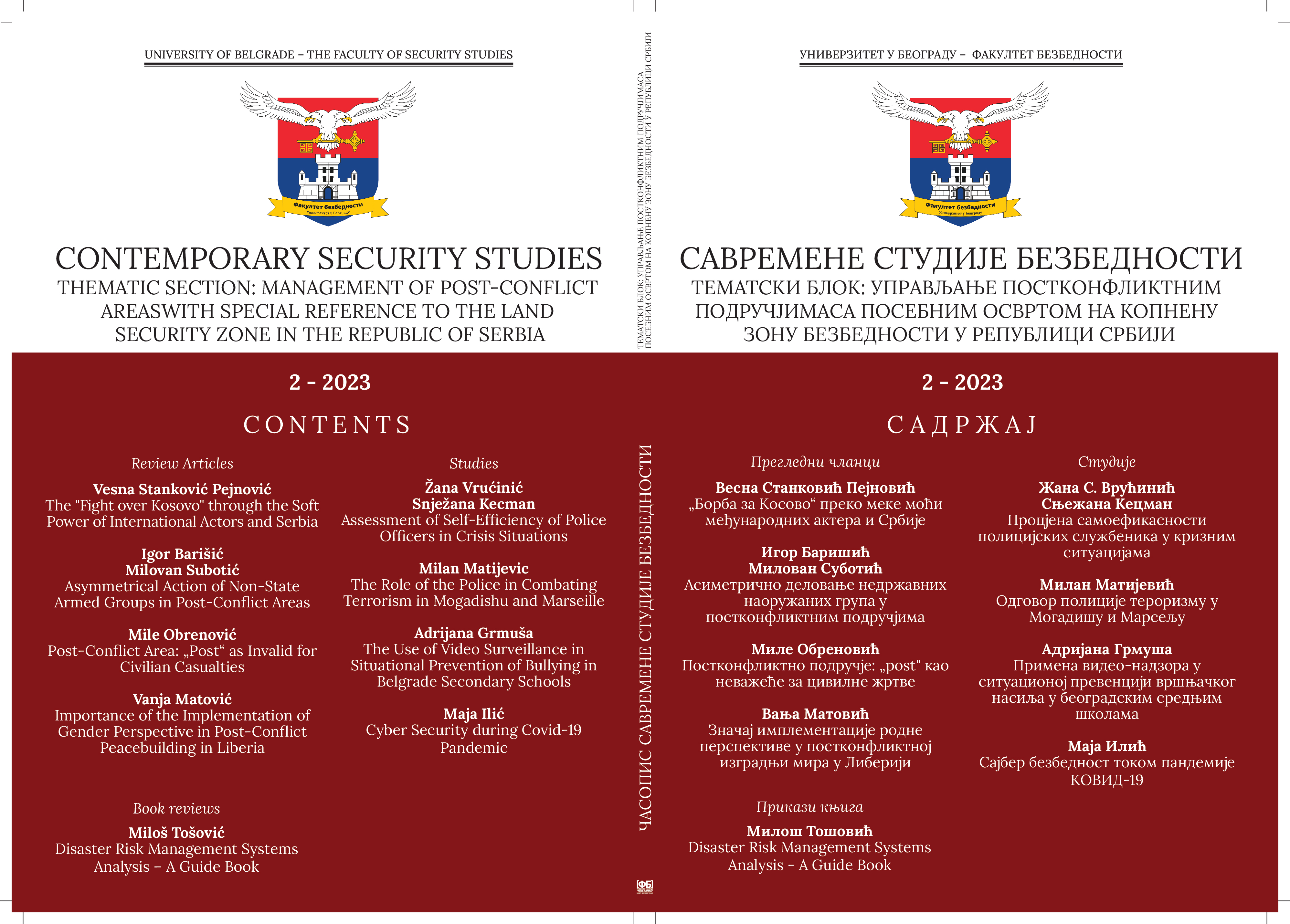Post-Conflict Area: „Post“ as invalid for civilian casualties
Abstract
Civilian casualties in an armed conflict are often directly related to the time period of the armed conflict and the geographical area where it takes place. Accordingly, the data on civilian casualties are often referred to only those casualties that occur in the conflict area during the armed conflict, that is, civilian battle-related deaths. This raises the question of whether the post-conflict area, which is etymologically composed from a compound meaning the area "after the conflict", means that the end of the armed conflict, in a certain area also means the end of all the causes that arose as a result of the conflict and which lead to the occurance of civilian casualties? In response to this question, the author comes to the data that civilian victims can also occur due to various indirect (non-violent) causes of death, that is conflict-related deaths, which are a consequence of an armed conflict, but which are not territorially or temporally limited by an armed conflict. Accordingly, the post-conflict area is "post“-conflict when it comes to the manifest nature of the armed conflict, it means the area in which armed activities have ended and in which there are no more battle-related deaths. However, the post-conflict area is not "post“-conflict when it comes to the latent nature of armed conflicts, and the end of the armed conflict does not mean the end of its negative consequences that lead to civilian casualties. Thus, a large number of civilian victims caused by conflict-related deaths also appear in the post-conflict area.
References
Allen, L. N., Aghilla, M., Kak, M., Loffreda, G., Wild, C. E. K., Hatefi, A., Herbst, C.H. & El Saeh, H. (2022). Conflict as a macrodeterminant of non-communicable diseases: the experience of Libya. BMJ global health, 7:e007549.
Bell, K., Crawford, N.C., Guarasci, B., Miller, R., Pemberton, M., Rubaii, K & Skelton, M. (2019). Enviromental costs. Retrieved 10.10.2023. from https://watson.brown.edu/costsofwar/costs/social/environment
Clausewitz, C. V. (1976). On war. Edited and Translated by Michael Howard and Peter Paret. New Jersey: Princeton University Press.
Connolly, M. A. & Heymann, D. L. (2002). Deadly comrades: war and infectious diseases. The Lancet, 360, 23-24.
Cunningham, A. J. (2017). Post-conflict contexts and humanitarian organizations: the changing relationship with states. Journal of International Humanitarian Action, 2(1), 1-10.
Dennen, J. M. G. (2005). „Introduction: On Conflict“. In: vander Dennen, J.M.G. & Falger, V.S.E. (eds.) The Sociobiology of Conflict. London: Chapman & Hall. 1-19.
Dinstein, Y. (2005). „Collateral Damage and the Principle of Proportionality”. In: Wippman, D. & Evangelista, M. (eds). New Wars, New Laws? Applying Laws of War in 21st Century Conflicts. Leiden: Brill - Nijhoff. pp. 211-224
Echarren, P.Y. (2013). „Hunger and Conflict”. In: Castro Fernández, S. (ed). Food Security and Global Security. Madrid: Spanish Institute for Strategic Studies. pp. 171-194.
Equality Commision for Northern Ireland. (2007). Definition of Disability: The Disability Discrimination Act 1995. Retrieved 10.10.2023. from https://www.equalityni.org/ECNI/media/ECNI/Publications/Employers%20and%20Service%20Providers/DefinitionofDisability07.pdf
Goniewicz, K., Burkle, F. M., Horne, S., Borowska-Stefańska, M., Wiśniewski, S. & Khorram-Manesh, A. (2021). The influence of war and conflict on infectious disease: a rapid review of historical lessons we have yet to learn. Sustainability, 13(19), 10783.
Kitić, S. (2020). Upravljanje konfliktom u organizacijama. Engineering management 6(2), 86-97.
Messer, E., Cohen, M. J. & Marchione, T. (2001). Conflict: A cause and effect of hunger. Environmental Change and Security Project, Report 7, pp. 1–16.
Morgan, R. K. & Summer, R. (2008). Chronic Obstructive Pulmonary Disease. International Encyclopedia of Public Health, 709–717.
Ngaruiya, C., Bernstein, R., Leff, R., Wallace, L., Agrawal, P., Selvam, A., Hersey, D. & Hayward, A. (2022). Systematic review on chronic non-communicable disease in disaster settings. BMC Public Health, 22(1), 1-88.
Office of the United Nations High Commissioner for Human Rights. (n.d.). Technical Guidance Note on SDG Indicator 16.1.2 Number of conflict-related deaths per 100,000 population, by sex, age and cause. Retrieved 20.09.2023. from https://www.ohchr.org/sites/default/files/Documents/Issues/HRIndicators/SDG_Indicator_16_1_2_Guidance_Note.pdf
Popović, B., Petrović, D., Ilić, D. & Krivačić, M. (2006). Susret sa jakim emocijama. Vodič za primenu programa Istraživanje humanitarnog prava u postkonfliktnom kontekstu. Beograd: MKCK.
Ramsbotham, O., Woodhous, T. & Miall, H. (2011). Contemporary conflict resolution: the prevention, management and transformation of deadly conflicts. Third Edition. Cambridge: Polity.
Ratnayake, R., Degomme, O., Altare, C., Guha-Sapir, D., Bijleveld, C., Melhbaum, S. & Hoex, L. (2008). The many victims of war: Indirect Conflict deaths.Global Burden of Armed Violence (pp 31-48). Geneva: Geneva Declaration Secretariat.
Rezaeian, M. (2009). A review on the most important consequences of wars and armed conflicts. Middle East Journal Of Business, 4(1), 7-9.
The World Bank. (n.d.). Metadata Glossary. Retrieved 20.09.2023. from https://databank.worldbank.org/metadataglossary/world-development-indicators/series/VC.BTL.DETH
Tjosvold, D. (2006). Defining conflict and making choices about its management: Lighting the dark side of organizational life. International Journal of Conflict Management, 17(2), 87–95.
UCDP. (n.d.c). Definitions, sources and methods for Uppsala Conflict Data Program Battle-Death estimates. Retrieved 21.09.2023. from https://ucdp.uu.se/downloads/old/brd/ucdp-brd-conf-41-2006.pdf
United Nations (2023). Conflict and Violence are the Primary Causes of Hunger and Famine, Special Rapporteur on the Right to Food Tells the Human Rights Council. Retrieved 09.10.2023. from https://www.ohchr.org/en/news/2023/03/conflict-and-violence-are-primary-causes-hunger-and-famine-special-rapporteur-right
Обреновић, М. (2023). Процена броја цивилних жртава у оружаним сукобима. Мастер рад. Београд: Факултет безбедности
Роквић, В. (2017). Системи одбране. Београд: Факултет безбедности

